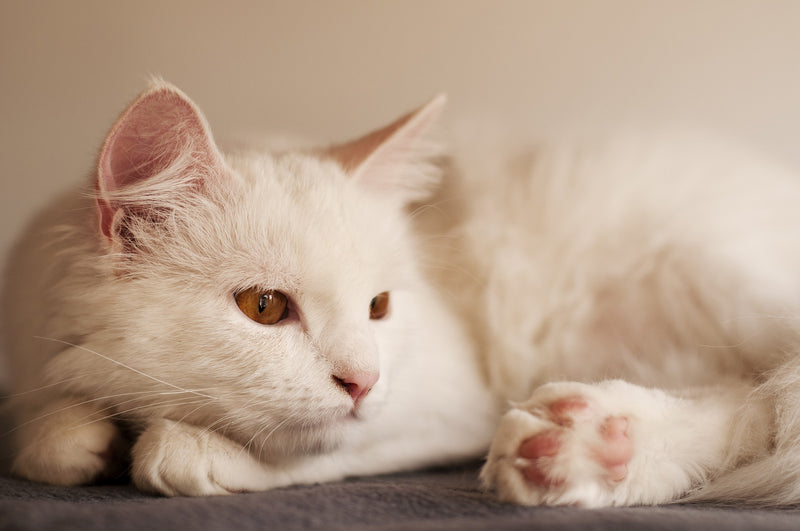
The posh and plush Turkish Angora is an ancient, natural breed from Turkey. Interestingly, it is believed that the white coat and long fur in domestic cats may have originated from this ancient breed. How marvelous! Here is the fascinating story of Turkish Angora, the national treasure of its native country.
Main features
The Turkish Angora has a long, posh and silky coat and an elegant, graceful, yet strong body. Female Turkish Angoras weight between 8 and 12 lbs., and males typically weigh more than 12 lbs. Although they are famous for their shimmery white fur, the coat of this cat can also be tabby (brown or white), black with a brown undercoat or a variety of smoke tones.
The only colors that are not permitted in the breeding program are pointed, chocolate and lilac. The eyes are almond-shaped and come in a variety of colors, including blue, copper, green and gold. Heterochromia is also relatively common in this breed. Ears are pointed and the tail is rich and upright.

Origins
The Turkish Angora, like all domestic cats, is descended from the African wildcat and has developed through natural selection in the regions of Anatolia in Turkey. The breed was officially recognized in Europe already in the 17th century (Azan & Rodgers, 2015). Turkish Angoras were used for the development of the Persian breed, as cat fanciers selected them for their luxurious coat.
Frances Simpson wrote in her book "The Book Of The Cat" that in the 19th century, the two breeds were so similar in appearance that they were hardly distinguishable. In the 20th century, however, after the Persian cats were selected for their flat face feature, their appearances significantly diverged. It was also in the 20th century that a breeding program was started by the Ankara Zoo, which began protecting and preserving pure Angora cats.
This program particularly favored white cats with odd eyes. In The United States, The Cat Fanciers' Association officially recognized the breed in 1963, but only white Angoras were accepted until 1978. Today, all the registries in The U.S. recognize many coats and patterns of Turkish Angoras.
It is believed that the mutations associated with white fur and long hair in domestic cats may have originated in this breed. Turkish Angora, together with the Persian and Siberian Forest breeds, are all considered possible ancestors of all modern long-haired domestic cats.

Personality
Turkish Angoras are happy, playful and intelligent little companions. They are curious and they love to be involved in the everyday activities of their hoomans. They often bond with one person, whom they can become very protective of. They are energetic, playful and cheerful. They love to climb, play and hunt. They are exceptionally intelligent and very trainable too. Turkish Angora is a great companion for families with children and other pets.
Health and care
The genes associated with the white coat (the dominant white gene, as well as the white-spotting gene) seem to be linked to hearing abilities. Deafness in white cats seems to be associated with the white spotting gene and dominant white gene, but not with the albino white gene.
Deafness in white cats is more common among those cats with blue eyes or with heterochromia. This is because the white gene can occasionally cause the degradation of the cochlea aside from disrupting melanocyte migration into one or both eyes. The Cochlea is the part of the inner ear involved in hearing. This results in irreversible deafness in one or both ears (Starbuck & Thomas, 2004).
Other genetic conditions found in the breed are also hereditary ataxia and hypertrophic cardiomyopathy. Hereditary ataxia is a lethal, autosomal recessive, neurological condition. Hypertrophic cardiomyopathy (HCM) is a disease that affects the heart muscle (myocardium).

Interesting facts about the ancient cat
1. Turkish Angora is the ballerina of the cat world. This beautiful cat is sometimes described as the ballerina of the cat world, thanks to their elegance combined with remarkable strength.
2. Their long coat is not high-maintenance. Turkish Angora's luxurious and plush long coat is so silky that it rarely ever mats. This cat requires surprisingly minimal grooming! Typically, weekly grooming is sufficient enough to maintain their coat hygiene.
3. They are attention-seekers. This family cat is very friendly and energetic. They love to move, run, climb and play. Don't be surprised if you find your Turkish Angora on the fridge! Because of their active spirit combined with the friendly personality, this little companion can be very attention demanding.
4. They may require some training. Turkish Angoras are highly intelligent and trainable. However, because of their energetic spirit, you may have to train them in order to prevent inappropriate behavior. Just like dogs, these plush little companions can be a handful. It just makes us love them even more!
5. This Turkish breed is still shown in a Zoo in Ankara. This Turkish breed, considered the national treasure of the country, is still maintained at the Ankara Zoo and you can still see the representatives of the original breed there.

The national treasure of its home country, Turkish Angora, is a luxurious, ancient cat breed. Elegant and strong, beautiful and smart, this cat seems to have it all! These friendly companions love to play, train and even swim. They're a great addition to any family out there!
Citations
1. Barbara Azan and Sandralee Rodgers. "The Turkish Angora: About This Breed". CFA inc. The Cat Fancier's Association. Retrieved 2 January 2015.
2. Starbuck O. & Thomas D. (2004). Cat Color FAQS: Cat Color Genetics.Retrieved from CatFanciers.com.
